It’s time to embrace the loving holiday spirit, and end the harsh stereotype that figgy pudding is just a feared fruitcake. After all, it is named in quite a few jolly verses in a popular Christmas carol.
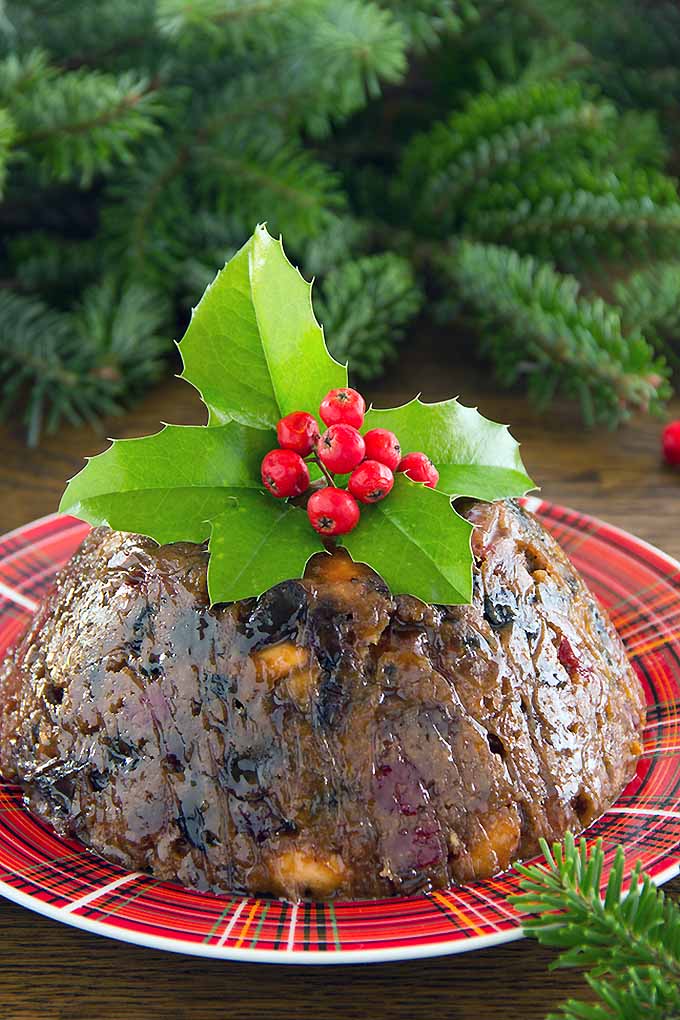
Since holiday carolers demand this treat repeatedly every single year during the holidays (and won’t go until they get some), there must be something special about it.
This is what we will be exploring throughout this article. What exactly is this highly in-demand dessert of Christmas carol fame?
First, we’ll take a look at the traditional ingredients and how it’s typically made. Then, we will go over the historical, cultural, and religious significance of it, and explore the reasons why America is hesitant to welcome it among the other more popular winter desserts.
Now bring us some figgy info!
Beyond the Fruitcake: Ingredients and How It’s Made
American cookbook author and culinary extraordinaire Dorie Greenspan describes it as an “exotic” dessert that will “taste like nothing else in your holiday spread.”
I have to agree – it is truly one of a kind.
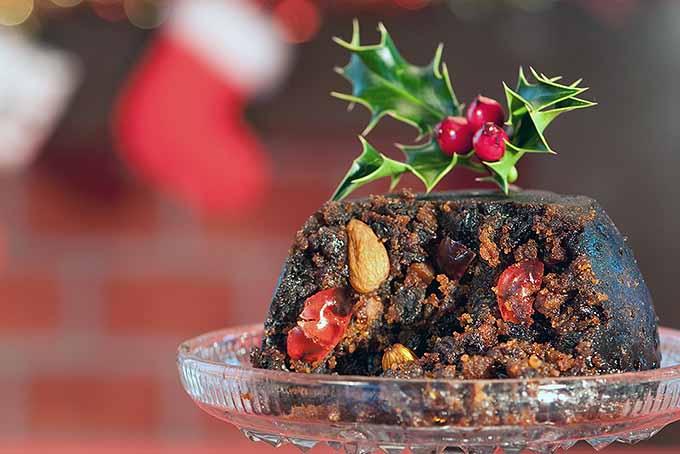
Even the name has its own unique charm.
Besides the title “figgy pudding” as it has been popularized in a sweet melody, you may know this dessert by its other monikers: Christmas pudding, plum pudding, plum porridge, fruit pudding, or steamed pudding.
By no means a creamy, liquid pudding as it’s typically known according to American standards (chocolate or vanilla, anyone? ), this particular usage denotes the British use of the word, a generic term for dessert.
The most traditional version is a molded and steamed cakelike dessert, usually dome-shaped. It’s a moist mixture of assorted dried fruits, warming spices, eggs, bread crumbs or flour, butter, sugar and a hefty helping of alcohol like brandy, rum, or cognac. Or even all three.
The dried fruits are certainly not limited to just figs or plums. Depending on the recipe, you can use a mixture of dried or candied cherries, blueberries, cranberries, raisins, and apricots as well.
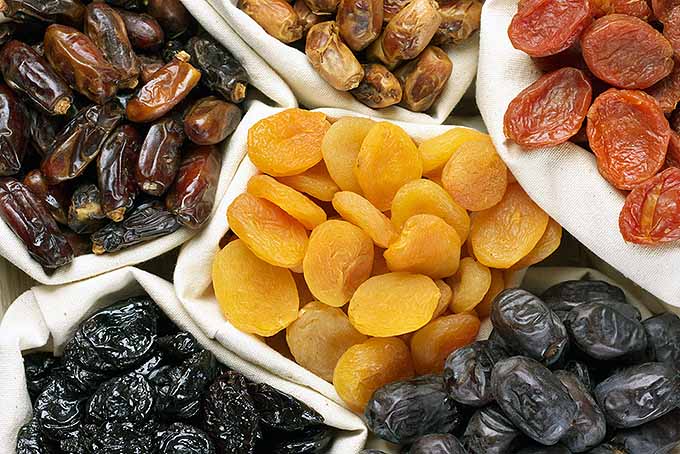
Once all of the ingredients are combined, the batter is poured into a mold, covered, and placed in a large steamer pot of boiling water that’s covered with a lid. It is typically steamed for a few hours until the batter has been cooked completely.
While you can enjoy it the day it’s made, it is traditionally wrapped and allowed to rest for a period of time, usually at room temperature in a cool, dry location. It is aged for a few weeks, even a couple months, in order to continue developing the strong flavors.
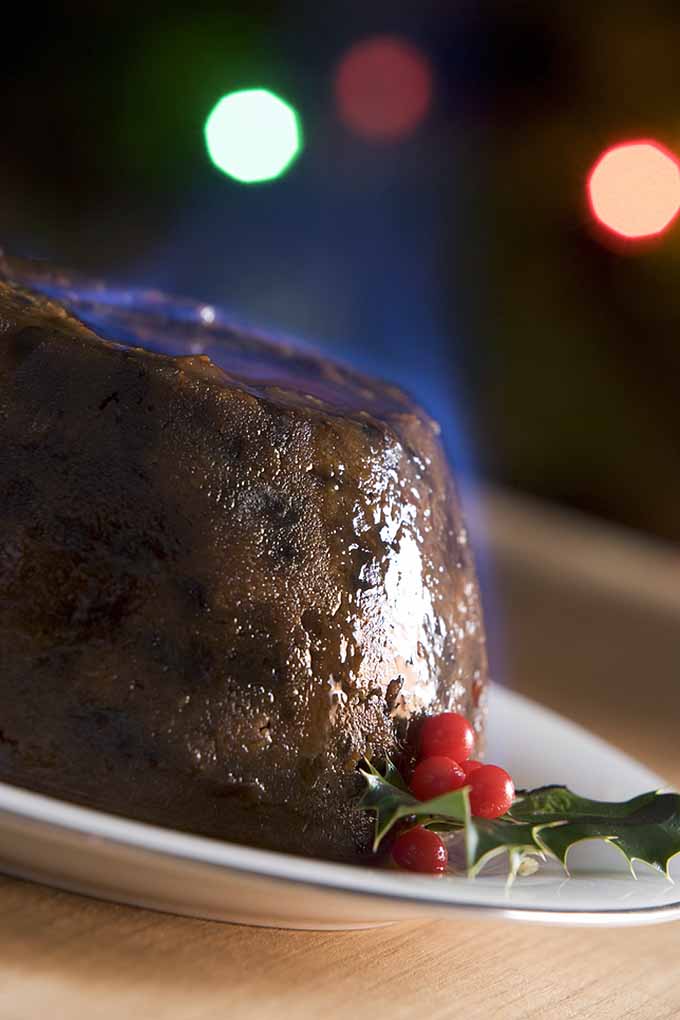
The long-lasting nature of this “sturdy sweet,” as Greenspan calls it, is attributed to the alcohol, preserved fruits, and long cooking time.
Once Christmas comes and the feast is finally ready, the pudding is re-steamed for an hour or so to warm it before serving.
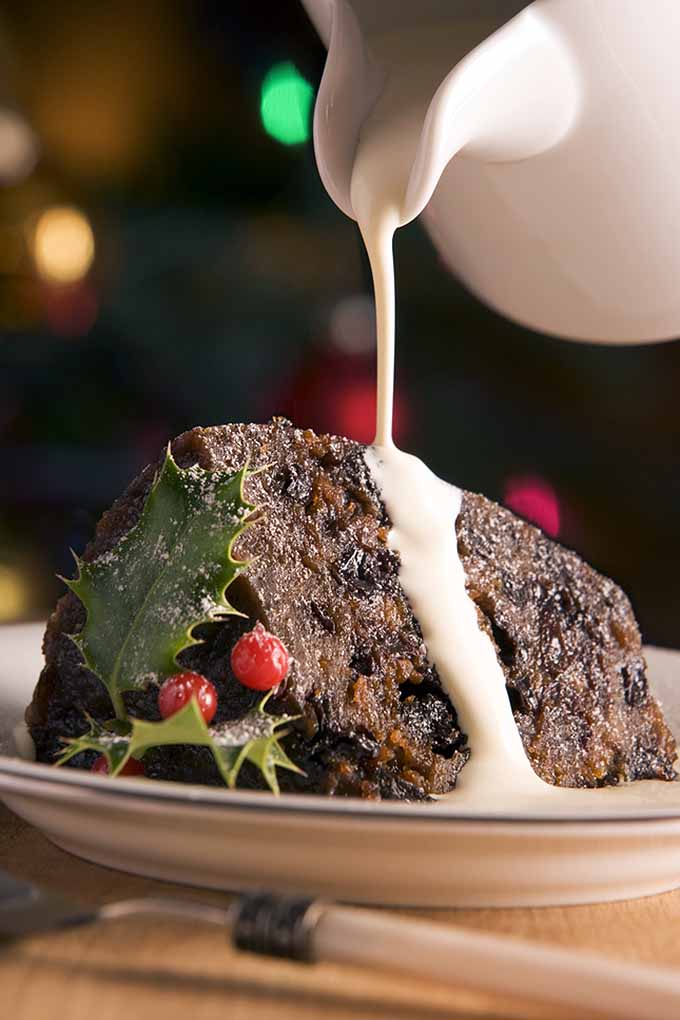
Following the traditional method, it is doused with a bit of brandy, set aflame, and served once the flames go out.
Typical toppings include a sweet white sauce (known as hard sauce), icing, or whipped cream to offset the deep richness. And a sprig of holly and fresh cranberries for decoration.
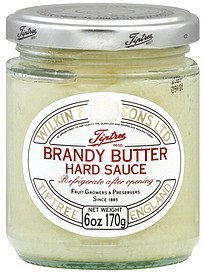
Tiptree Brandy Butter Hard Sauce
Now that you have a basic understanding of what it is and how it’s made, let’s dive even deeper into the historical, cultural, and religious significance of this fruity cake!
Medieval English Roots
According to writer Nate Barksdale, this dessert is a classic British holiday dish, dating back as early as the 15th century.

Barksdale writes that figgy pudding is actually a sweet development from medieval English sausages, in which “fat, spices, and fruits (the best preservatives of their day) were mixed with meats, grains, and vegetables and packed into animal stomachs and intestines” to preserve the food for long periods of time.
Christmas Plum Pudding for your holiday table, without the work! Available on Amazon.
The earliest version recorded in history, called plum pottage, was a savory mishmash served at the beginning of the meal. “Plum” was a generic pre-Victorian term referring to any kind of dried fruit available, most commonly raisins and currants such as blackcurrants.
As more assorted dried and candied fruits became more accessible in England near the end of the 16th century and beyond, it transitioned from a savory cooked meat concoction to a sweeter, steamed mixture of a variety of dried fruits in addition to the other ingredients.
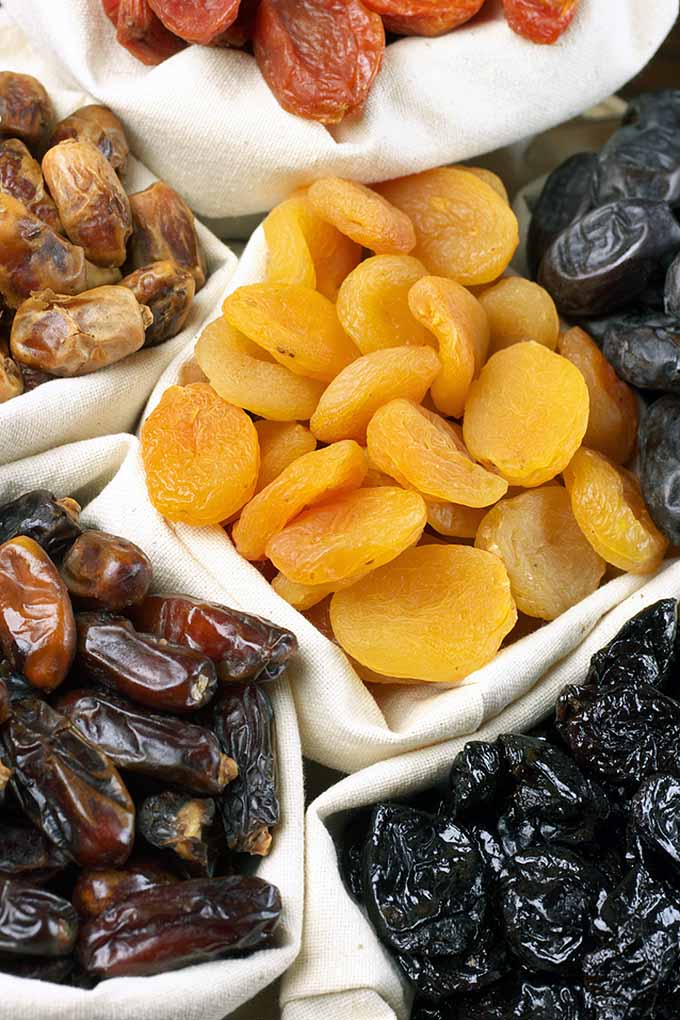
And with the development of pastry pans and molds as well as pudding cloths, a fabric that could hold and preserve a variety of puddings, using the linings of animal stomachs and intestines was no longer necessary.
However, the dish was not completely devoid of animal products. Animal suet was (and still is) an important traditional ingredient in figgy puddings. It serves as a means of binding ingredients together, and imparts a deliciously fatty, unctuous quality to the final product.
Christian Symbolism
From its early creation, figgy pudding is deeply rooted in Christian symbolism as a tribute to Jesus Christ.
NPR writer Debbie Waugh notes that a classic recipe would have exactly thirteen ingredients, which would represent Christ and his twelve apostles.
To honor the Christian tradition, families typically would make these at home five weeks before Christmas, on the last Sunday before Advent. The pudding would then be aged throughout the weeks leading up to the holiday.

The grand finale before consuming the dessert also holds great religious significance. Some say pouring a little brandy over the top and setting it on fire dramatically represented the passion of Christ. The flames were said to signify the fierce, relentless, yet transitory suffering he endured.
The traditional garnish of the holly sprig also has religious meaning. Though it was used to ward off evil spirits and served as a representation of new life during pre-Christian celebrations of the winter solstice, this symbol – like many others – was absorbed into Christian tradition.
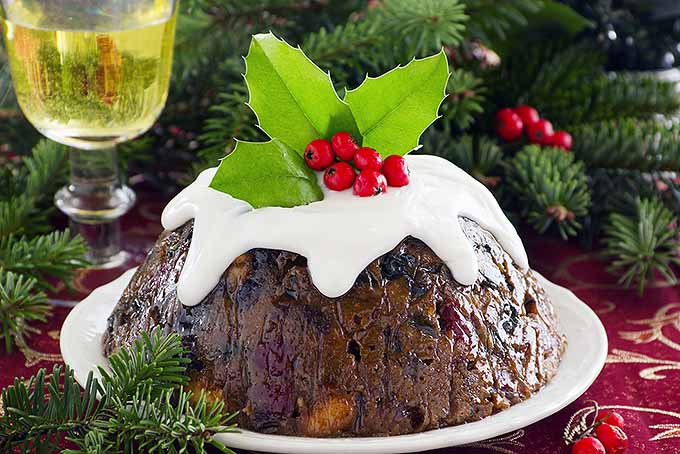
For those who longed to keep their holly after Christianity reached Western Europe, as a form of decoration at this time of year, it was said to symbolize the crown of thorns that Jesus was forced to wear.
A Ban on Pudding
The English Puritanical reign in the early to mid-17th century led to a heavy ban on the Christmas celebration and all its Christian idolatry, including many of the traditions and trappings surrounding the holiday. Yule logs, caroling, and nativity scenes were banned during this time.
Figgy pudding also became a forbidden item of the holiday season.
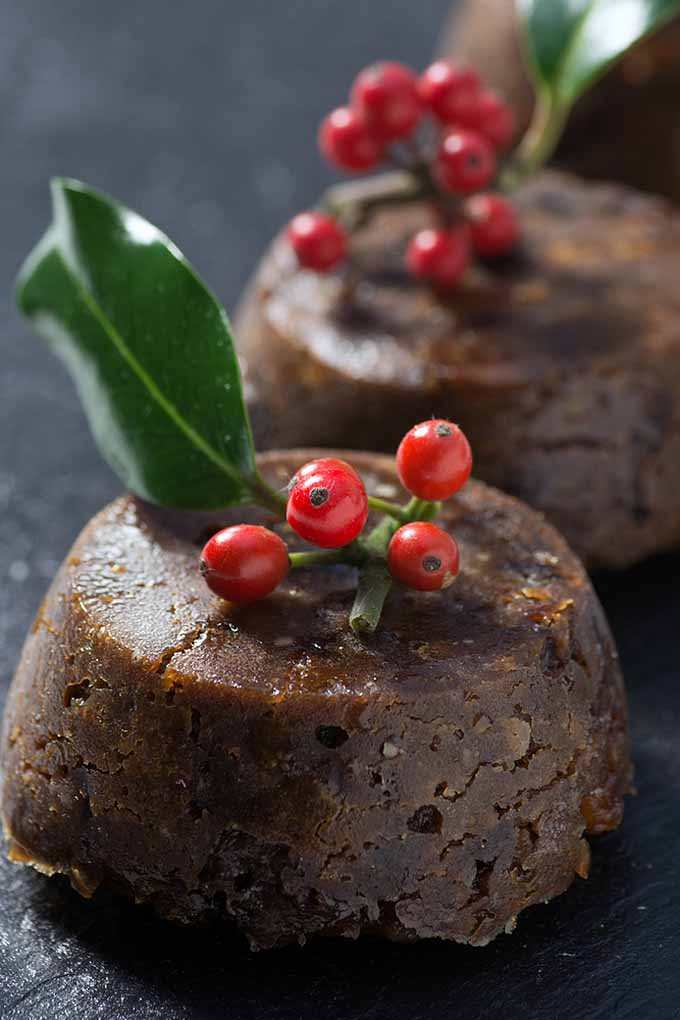
It may have been the high – and therefore sinful – alcohol content in the pudding, or its symbolic meaning, that caused the Puritans to condemn the dessert.
The ban did not last long, however. The English monarchy, and the Anglicanism of the Church of England, were soon restored in the later half of the 17th century. Christmas was reinstated as a celebrated holiday, and figgy puddings – as well as all other renowned holiday treasures – were allowed once more.
Sweet Victorian Pleasures
Moving forward to the Victorian era in England, figgy puddings were certainly beloved as a special dessert at Christmastime.

Because it contained ingredients that were costly, and due to the laborious process of making it, most Victorian families reserved making this dessert for the holiday season only.
The pudding was a common symbol of the Victorian Christmas, and it was given eternal literary popularity in Charles Dickens’ novel A Christmas Carol:
“Mrs. Cratchit entered – flushed, but smiling proudly – with the pudding, like a speckled cannon-ball, so hard and firm, blazing in half of half-a-quarter of ignited brandy, and bedight with Christmas holly stuck into the top.”
Concrete expectations for the family unit existed during the Victorian era in England, which thrived on devotion, benevolence, and charity. All were heightened during the widely celebrated Christmas holiday.
Journalists, politicians, and novelists like Dickens all aimed to create an ideal wintry scene for the standardized Victorian family: surrounded by loved ones, seated around a table to enjoy a some sort of roasted bird, perhaps a goose… and figgy pudding.
An American Curiosity
Unlike England and some of surrounding British-influenced countries, this much-loved treat is not a common holiday dessert here in America.
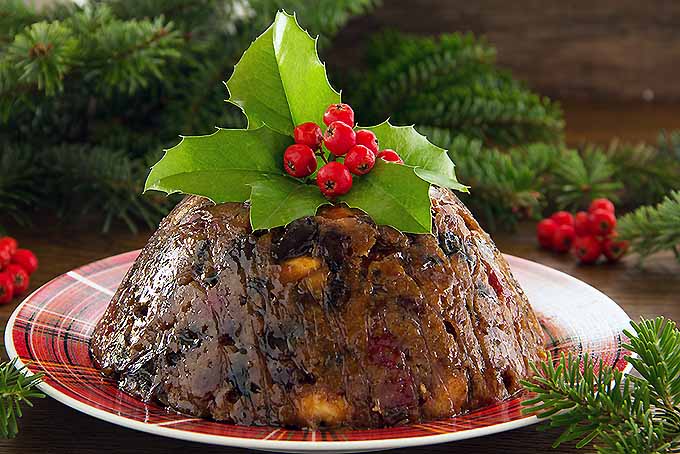
Rather than sharing the table with its sugary and simple counterparts like sugar cookies and multiple fruit and nut pies, figgy pudding is most often relegated to the inedible and imagined confines of books and song.
The popular “We Wish You a Merry Christmas,” in which carolers sing of figgy pudding, is of English origin – no surprise there. It hints at the tradition of wealthier English citizens handing out money and treats (like our special dessert) to those who were caroling, or gifts given to laborers after the holidays on Boxing Day.
I highly doubt that many Americans today would ask for a slice of figgy pudding while caroling.
Even with the significant early British influence on American cuisine throughout Colonial America, this type of sweet gradually disappeared from Christmas menus to make way for simpler desserts that were easier to make, with less complex flavor combinations.
This may have been due to the American Revolution and the passionate yearning to become an independent society. The drive to separate from the British monarchy caused the earliest generations of American colonists to willingly abolish many English customs, including certain Christmas dishes.

Concerning modern tastes and the desire for the immediate, it may have been too complicated and time-consuming to make, especially when cooks were already concerned with all the other holiday menu items that take precedence over an excessively spiced, boozy fruitcake with a lengthy list of ingredients and an even longer list of instructions.
And in the presence of build-your-own kits for gingerbread houses and easy sugar cookie cutouts, it is completely understandable why many home cooks would rather buy premade, store-bought alternatives than make their desserts completely from scratch.
Oh, convenience… the usual culprit when it comes to doing away with time-honored traditions!
Getting Figgy with It
Though it is a dessert that has certainly lost its popularity as a dish at our own holiday feasts, we can still admire its timeless charm and quintessentially Christmas-y identity!
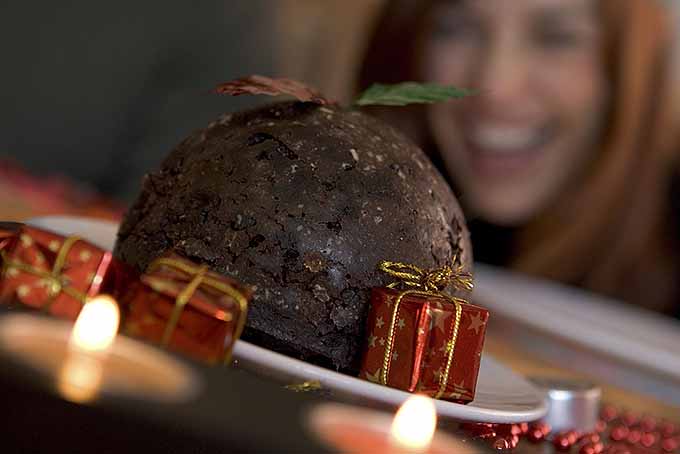
What’s your own experience with figgy pudding? Is it worth stepping out of your comfort zone of tried and true Christmas pies and cookies to make? Have you tried a premade one?
Now that you know more about it, would you be willing to give this a try? Let us know in the comments below!
Photo credits: Shutterstock.
About Nikki Cervone
Nikki Cervone is an ACS Certified Cheese Professional and cheesemonger living in Pittsburgh. Nikki holds an AAS in baking/pastry from Westmoreland County Community College, a BA in Communications from Duquesne University, and an MLA in Gastronomy from Boston University. When she's not nibbling on her favorite cheeses or testing a batch of cupcakes, Nikki enjoys a healthy dose of yoga, wine, hiking, singing in the shower, and chocolate. Lots of chocolate.


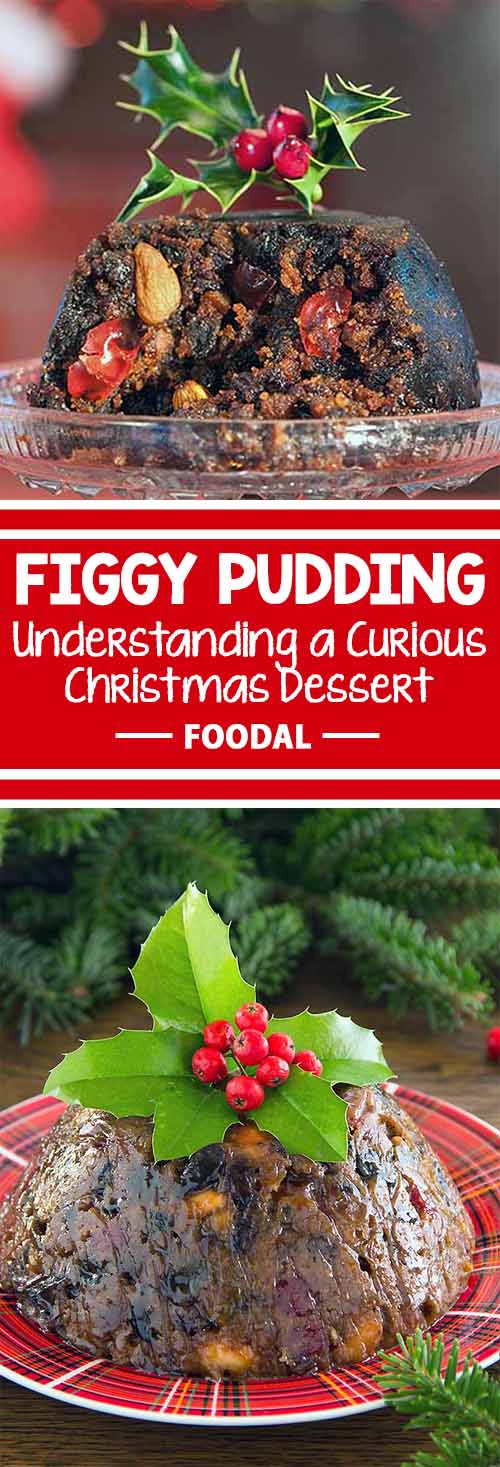



I never thought I would want to try some figgy pudding, but I do now! Thanks for the humor and information on it.
I found a recipe and I think I might give it a shot.
Even though it will be a little late for Christmas
I don’t have a big family so waiting for it til after
Christmas is ok with me.
I have always wanted to make a figgy pudding. I am planning to do it on Stir up Sunday! I know it will be a strange taste combination, but i can’t wait to light it up and taste it!